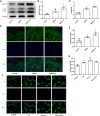Liraglutide Ameliorates Erectile Dysfunction via Regulating Oxidative Stress, the RhoA/ROCK Pathway and Autophagy in Diabetes Mellitus
- PMID: 32903510
- PMCID: PMC7435068
- DOI: 10.3389/fphar.2020.01257
Liraglutide Ameliorates Erectile Dysfunction via Regulating Oxidative Stress, the RhoA/ROCK Pathway and Autophagy in Diabetes Mellitus
Abstract
Background: Erectile dysfunction (ED) occurs more frequently and causes a worse response to the first-line therapies in diabetics compared with nondiabetic men. Corpus cavernosum vascular dysfunction plays a pivotal role in the occurrence of diabetes mellitus ED (DMED). The aim of this study was to investigate the protective effects of glucagon-like peptide-1 (GLP-1) analog liraglutide on ED and explore the underlying mechanisms in vivo and in vitro.
Methods: Type 1 diabetes was induced in rats by streptozotocin, and the apomorphine test was for screening the DMED model in diabetic rats. Then they were randomly treated with subcutaneous injections of liraglutide (0.3 mg/kg/12 h) for 4 weeks. Erectile function was assessed by cavernous nerve electrostimulation. The corpus cavernosum was used for further study. In vitro, effects of liraglutide were evaluated by primary corpus cavernosum smooth muscle cells (CCSMCs) exposed to low or high glucose (HG)-containing medium with or without liraglutide and GLP-1 receptor (GLP-1R) inhibitor. Western blotting, fluorescent probe, immunohistochemistry, and relevant assay kits were performed to measure the levels of target proteins.
Results: Administration of liraglutide did not significantly affect plasma glucose and body weights in diabetic rats, but improved erectile function, reduced levels of NADPH oxidases and ROS production, downregulated expression of Ras homolog gene family (RhoA) and Rho-associated protein kinase (ROCK) 2 in the DMED group dramatically. The liraglutide treatment promoted autophagy further and restored expression of GLP-1R in the DMED group. Besides, cultured CCSMCs with liraglutide exhibited a lower level of oxidative stress accompanied by inhibition of the RhoA/ROCK pathway and a higher level of autophagy compared with HG treatment. These beneficial effects of liraglutide effectively reversed by GLP-1R inhibitor.
Conclusion: Liraglutide exerts protective effects on ED associated with the regulation of smooth muscle dysfunction, oxidative stress and autophagy, independently of a glucose- lowering effect. It provides new insight into the extrapancreatic actions of liraglutide and preclinical evidence for a potential treatment for DMED.
Keywords: autophagy; diabetes mellitus; erectile dysfunction; liraglutide; oxidative stress.
Copyright © 2020 Yuan, Ma, Gao, Wang, Li, Liu, Wang, Wang, Liu and Liu.
Figures






Similar articles
-
NOX1/4 Inhibitor GKT-137831 Improves Erectile Function in Diabetic Rats by ROS Reduction and Endothelial Nitric Oxide Synthase Reconstitution.J Sex Med. 2021 Dec;18(12):1970-1983. doi: 10.1016/j.jsxm.2021.09.007. Epub 2021 Oct 11. J Sex Med. 2021. PMID: 34649814
-
Role of JAK2 in the Pathogenesis of Diabetic Erectile Dysfunction and an Intervention With Berberine.J Sex Med. 2019 Nov;16(11):1708-1720. doi: 10.1016/j.jsxm.2019.08.014. Epub 2019 Sep 26. J Sex Med. 2019. PMID: 31564534
-
Ganoderma lucidum polysaccharide ameliorated diabetes mellitus-induced erectile dysfunction in rats by regulating fibrosis and the NOS/ERK/JNK pathway.Transl Androl Urol. 2022 Jul;11(7):982-995. doi: 10.21037/tau-22-428. Transl Androl Urol. 2022. PMID: 35958898 Free PMC article.
-
Mesenchymal Stem Cells Treatment for Erectile Dysfunction in Diabetic Rats.Sex Med Rev. 2020 Jan;8(1):114-121. doi: 10.1016/j.sxmr.2019.09.003. Epub 2019 Oct 22. Sex Med Rev. 2020. PMID: 31653438 Review.
-
The role of programmed cell death in diabetes mellitus-induced erectile dysfunction: from mechanisms to targeted therapy.Reprod Biol Endocrinol. 2025 Mar 3;23(1):32. doi: 10.1186/s12958-025-01368-1. Reprod Biol Endocrinol. 2025. PMID: 40033391 Free PMC article. Review.
Cited by
-
Tandem mass tag-based proteomic profiling revealed potential therapeutic targets and mechanisms of liraglutide for the treatment of impaired glucose tolerance.Front Endocrinol (Lausanne). 2022 Nov 14;13:1031019. doi: 10.3389/fendo.2022.1031019. eCollection 2022. Front Endocrinol (Lausanne). 2022. PMID: 36452319 Free PMC article.
-
Liraglutide Promotes Diabetic Wound Healing via Myo1c/Dock5.Adv Sci (Weinh). 2024 Oct;11(39):e2405987. doi: 10.1002/advs.202405987. Epub 2024 Aug 19. Adv Sci (Weinh). 2024. PMID: 39159301 Free PMC article.
-
The role of male hypogonadism, aging, and chronic diseases in characterizing adult and elderly men with erectile dysfunction: a cross-sectional study.Basic Clin Androl. 2023 Apr 6;33(1):5. doi: 10.1186/s12610-022-00182-8. Basic Clin Androl. 2023. PMID: 37020191 Free PMC article.
-
Association between composite dietary antioxidant index and erectile dysfunction: a cross-sectional study from NHANES.BMC Public Health. 2024 Dec 2;24(1):3362. doi: 10.1186/s12889-024-20880-4. BMC Public Health. 2024. PMID: 39623347 Free PMC article.
-
Adipose Tissue: A Novel Target of the Incretin Axis? A Paradigm Shift in Obesity-Linked Insulin Resistance.Int J Mol Sci. 2024 Aug 8;25(16):8650. doi: 10.3390/ijms25168650. Int J Mol Sci. 2024. PMID: 39201336 Free PMC article. Review.
References
LinkOut - more resources
Full Text Sources

